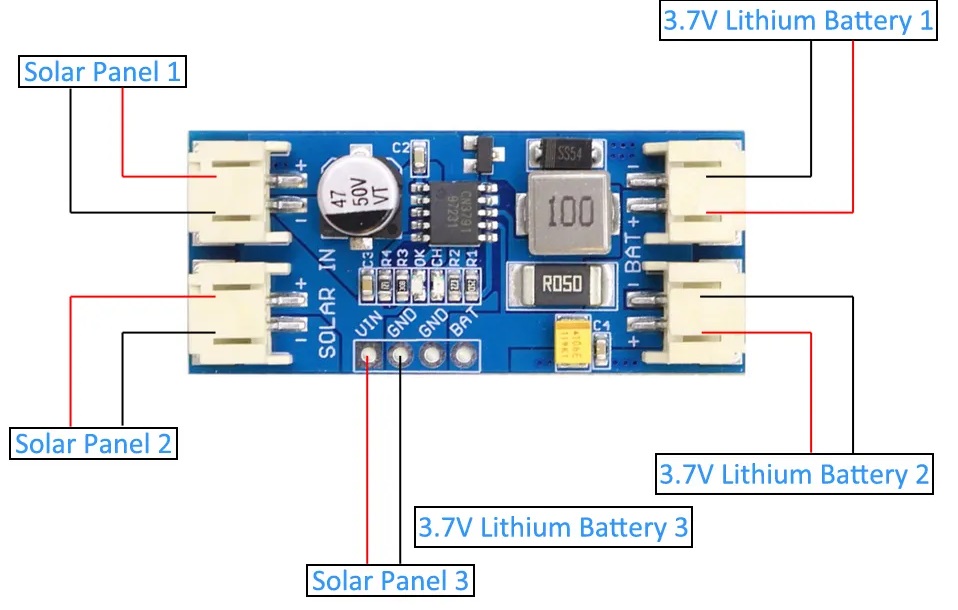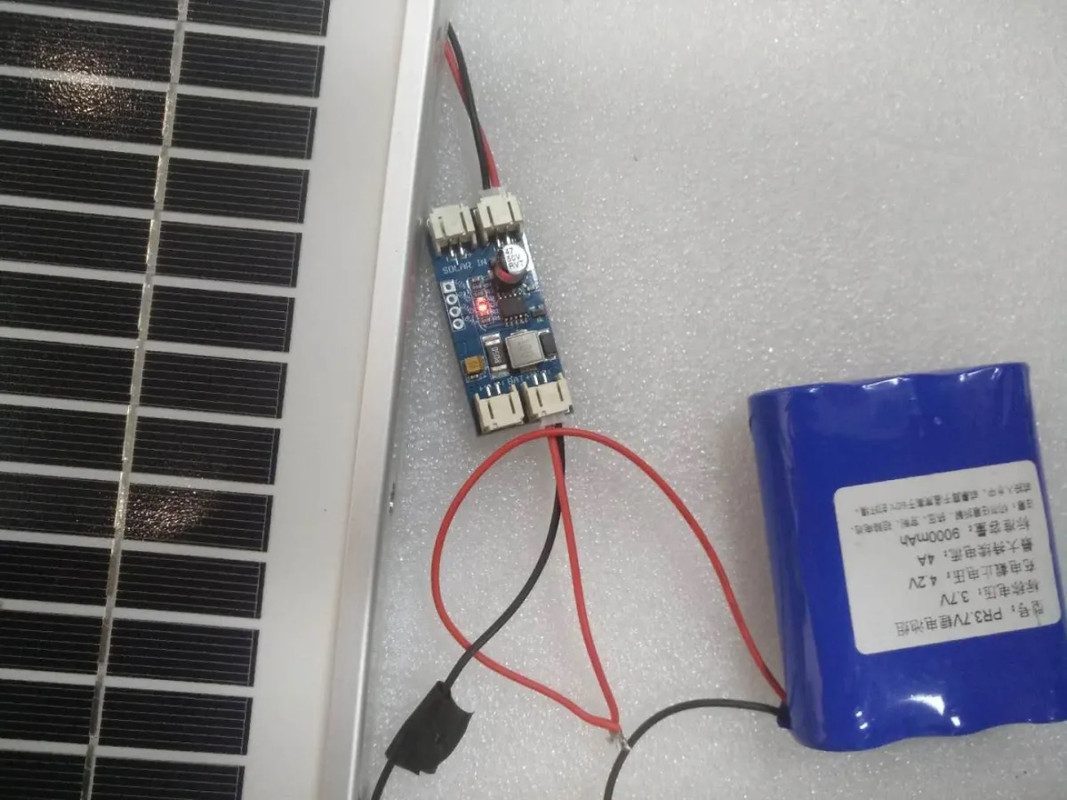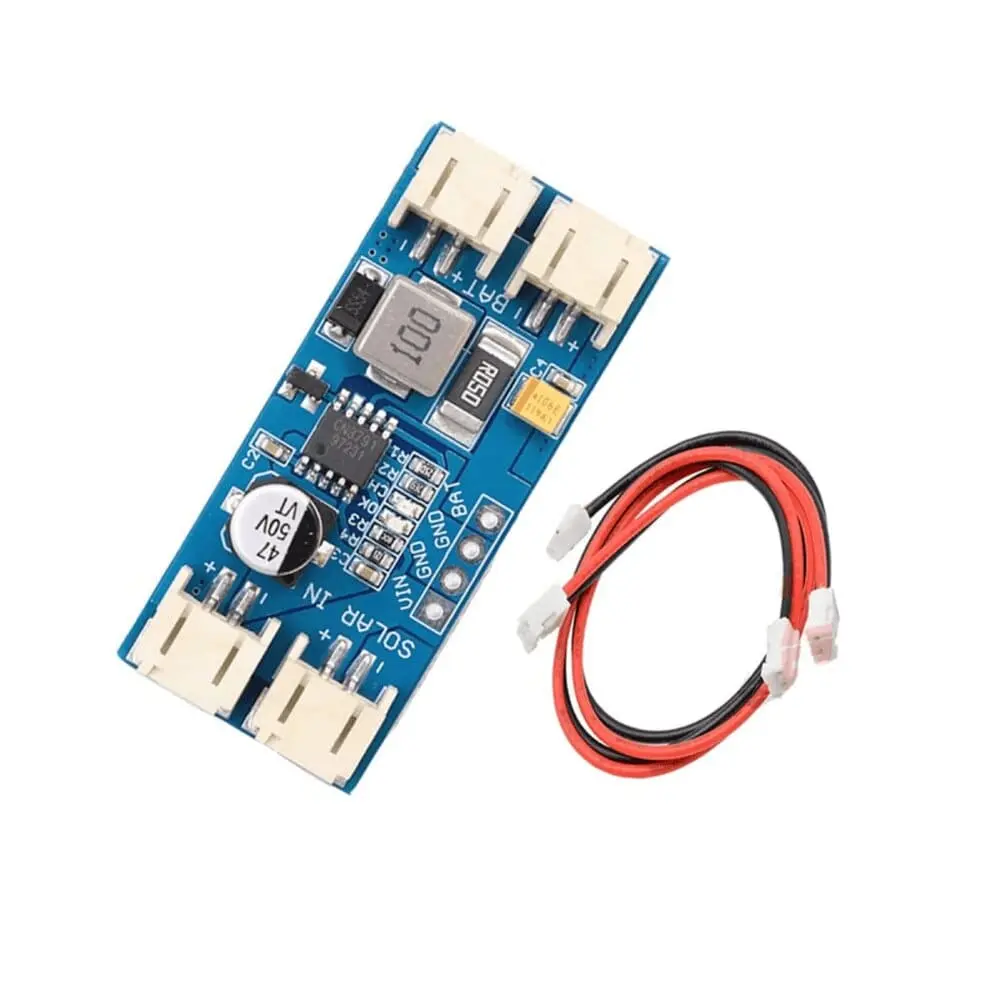Features:
- MPPT algorithm for solar panel maximum power point tracking
- Charge current up to 2A
- High-frequency 300KHz PWM switching
- Automatic and float charging support
- LED indicators for charge status
- Battery overvoltage protection
- Soft start to prevent inrush current
- Compact design: 45mm x 20mm x 9.5mm
- Wide operating temperature: -40°C to +85°C
Principle of Work:
MPPT (Maximum Power Point Tracking) allows the module to dynamically optimize the load seen by the solar panel for maximum energy transfer. PWM switching controls the output current and voltage for efficient and safe charging of lithium batteries. Float charge and automatic restart ensure proper charging of deeply discharged batteries.
Pinout of the Module:

- VIN: Solar panel positive input
- GND: Solar panel and battery ground
- BAT: Battery positive output
- OUT: Regulated output voltage
- LED: Charging status indicator
- JST Solar Panel 1,2: Input + GND
- JST Battery 1,2: Regulated output voltage
Applications:
- Solar-powered smartphone/tablet chargers
- Outdoor solar power systems
- Solar garden/pathway lights
- Remote telemetry and monitoring systems
- Solar irrigation and water pumping
- Environmental data loggers and stations
Circuit:

Connect the solar panel and battery using JST connectors according to the pinout.
Library:
No library needed
Code:
No code needed
Technical Details:
- Input voltage: 4.4V - 6V DC
- Max input power: 10W
- Charge current: Up to 2A
- Charge voltage: 4.2V ±1%
- Float charge: 4.18V ±1%
- Termination current: 0.1A
- Efficiency: Up to 95%
- PWM frequency: 300kHz
- Operating temperature: -40°C to +85°C
- Storage temperature: -40°C to +125°C
- Size: 45mm x 20mm x 9.5mm
- Weight: 7.3g
Comparisons:
- CN3791: 4.4V-6V input, 2A current, 95% efficiency
- Solar Lipo Charger v1.0 (DFRobot): 4.4V-7V input, 500mA current, 80% efficiency
- CN3791 is better for higher power and current applications, while Solar Lipo Charger is better for low-power, compact builds
Features:
- MPPT algorithm for solar panel maximum power point tracking
- Charge current up to 2A
- High-frequency 300KHz PWM switching
- Automatic and float charging support
- LED indicators for charge status
- Battery overvoltage protection
- Soft start to prevent inrush current
- Compact design: 45mm x 20mm x 9.5mm
- Wide operating temperature: -40°C to +85°C
Principle of Work:
MPPT (Maximum Power Point Tracking) allows the module to dynamically optimize the load seen by the solar panel for maximum energy transfer. PWM switching controls the output current and voltage for efficient and safe charging of lithium batteries. Float charge and automatic restart ensure proper charging of deeply discharged batteries.
Pinout of the Module:

- VIN: Solar panel positive input
- GND: Solar panel and battery ground
- BAT: Battery positive output
- OUT: Regulated output voltage
- LED: Charging status indicator
- JST Solar Panel 1,2: Input + GND
- JST Battery 1,2: Regulated output voltage
Applications:
- Solar-powered smartphone/tablet chargers
- Outdoor solar power systems
- Solar garden/pathway lights
- Remote telemetry and monitoring systems
- Solar irrigation and water pumping
- Environmental data loggers and stations
Circuit:

Connect the solar panel and battery using JST connectors according to the pinout.
Library:
No library needed
Code:
No code needed
Technical Details:
- Input voltage: 4.4V - 6V DC
- Max input power: 10W
- Charge current: Up to 2A
- Charge voltage: 4.2V ±1%
- Float charge: 4.18V ±1%
- Termination current: 0.1A
- Efficiency: Up to 95%
- PWM frequency: 300kHz
- Operating temperature: -40°C to +85°C
- Storage temperature: -40°C to +125°C
- Size: 45mm x 20mm x 9.5mm
- Weight: 7.3g
Comparisons:
- CN3791: 4.4V-6V input, 2A current, 95% efficiency
- Solar Lipo Charger v1.0 (DFRobot): 4.4V-7V input, 500mA current, 80% efficiency
- CN3791 is better for higher power and current applications, while Solar Lipo Charger is better for low-power, compact builds


